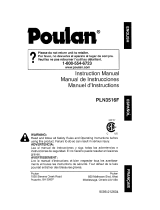
14. Disconnect the chain saw – Disconnect the chain
saw when not in use, before servicing, and when
changing accessories and attachments, such as the
saw chain and guard.
15. Outdoor use extension cords – Use only extension
cords that are marked and intended for outdoor use.
16. Stay alert – Watch what you are doing. Use common
sense. Do not operate the chain saw when you are
tired. Keep all parts of the body away from the saw
chain when the motor is operating.
Before you start the saw, make sure the saw chain is
not contacting anything.
17. Check for damaged parts – Before further use of
the chain saw, a guard or other part that is damaged
should be carefully checked to determine that it will
operate properly and perform its intended function.
Check for alignment of moving parts, binding of
moving parts, breakage of parts, mounting, and any
other conditions that may affect its operation. A guard
or other part that is damaged should be properly
repaired or replaced by an authorized service center
unless otherwise indicated in this instruction manual.
Have defective switches replaced by an authorized
service center. Do not use the chain saw if the switch
does not turn it on and off. Do not operate a chain
saw that is damaged, improperly adjusted, or is not
completely and securely assembled. Make sure
that the saw chain stops moving when the trigger is
released.
18. Guard against kickback –
mWARNING! KICKBACK
may occur when the nose or tip of the guide bar
touches an object, or when the wood closes in and
pinches the saw chain in the cut. Tip contact in some
cases may cause a lightning fast reverse reaction,
kicking the guide bar up and back towards the
operator. Pinching the saw chain along the top of the
guide bar may push the guide bar rapidly back towards
the operator. Either of these reactions may cause you
to lose control of the saw, which could result in serious
injury to the user. The following precautions should be
followed to minimize kickback:
a. Grip the tool rmly. When the motor is running,
hold the chain saw rmly by the front and rear
handle using both hands. Use a tight grip with
thumbs and ngers encircling the chain saw
handles. NOTE: If a manual oil-regulator control
is provided, additional or modied instructions
regarding its use are to be provided.
b. Do not overreach.
c. Keep proper footing and balance at all times.
d. Do not let the nose of the guide bar contact a log,
branch, ground or other obstruction.
e. Do not cut above shoulder height.
f. Use devices such as low kickback chain, guide bar
nose guard, chain brakes and special guide bars to
reduce the risks associated with kickback.
g. Only use replacement bars and chains specied by
the manufacturer or the equivalent.
19. Power supply – Connect the chain saw to the correct
voltage (i.e. make sure that the voltage supplied is the
same as that specied on the name plate of the tool).
20. Intended/not intended use – This chain saw is only
designed for the cutting of brushes, trunks or timber
beams up to a diameter according to the guide bar
length. It is only allowed to cut wood. This machine
is not intended to be used for any other purpose.
Furthermore, using this machine for professional
tree cutting services is strictly forbidden. During
operation of the chain saw, the user must wear
personal protective equipment as instructed in the
manual and follow the warning labels on the chain
saw. Intended use of the chain saw is detailed in the
manual. Please follow safety warnings. Everyone who
either uses the chain saw or performs maintenance
on it must be familiar with the instruction manual. Use
only manufacturer's original or approved spare parts
(e.g. guide bar, saw chain) and use only the allowed
combinations of guide bar/saw chain specied in this
manual.
The user, not the manufacturer, is completely liable for every
accident that results from non-intended use of the tool or for
injuries sustained as a result of an impermissible alteration of
the machine.
The chain saw is only intended for outdoor use.
Residual Risks – Intended/Not Intended
Use
Even when using the machine in accordance with its
prescribed intended use, there always remains a residual
risk, which cannot be prevented. According to the type and
construction of the appliance, the following potential hazards
may apply:
• Contact with exposed saw teeth of the saw chain
(cutting hazards).
• Access to the rotating saw chain (cutting hazards).
• Unforeseen, abrupt movement of the guide bar
(cutting hazards).
• Flung/dispersed parts from the work piece.
2












